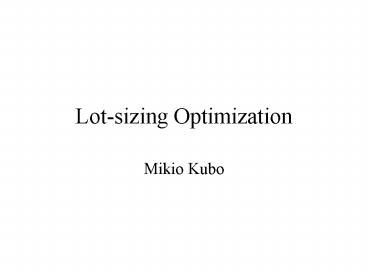Lotsizing Optimization PowerPoint PPT Presentation
1 / 30
Title: Lotsizing Optimization
1
Lot-sizing Optimization
- Mikio Kubo
2
Basic Single Item Model (1)Parameters
- T Planning horizon (number of periods)
- dt Demand during period t
- ft Fixed order (or production set-up) cost
- ct Per-unit order (or production) cost
- ht Holding cost per unit per period
- Mt Upper bound of production (capacity) in
period t
3
Basic Single Item Model (2)Variables
- It Amount of inventory at the end of period t
(initial inventory is zero.) - xt Amount ordered (produced) in period t
- yt 1 if xt gt0, 0 otherwise (0-1 variable),
i.e. , 1 production is positive, 0 otherwise
(it is called set-up variable.)
4
Basic Single Item Model (3)Formulation
5
Lot-sizing (Basic Flow) Model
Production x(t)
Inventory I(t-1)
I(t)
t
Demand d(t)
Week formulation
x(t)? Large M y(t) set-up variable
I(t-1)x(t) d(t)I(t)
0-1 variable
6
Valid Inequality
Then the inequality (called the (S,l) inequality)
is valid.
7
Valid Inequality,Cut,Facet
Inequality of week formulation (valid inequality)
Facet
Relaxed solution x
Solution x
Integer Polyhedron
Cut
8
Extended (Strong) FormulationNotations
Xst ratio of the amount produced in period s to
satisfy demand in period t ( )
The cost produced in period s
to satisfy demand in period t
9
Extended (Strong) FormulationFacility Location
Formulation
gt Strong formulation it gives an integer hull
of solutions
10
Lot-sizing ModelFacility Location Model
Ratio of the amount produced in period s to
satisfy demand in period t Xst
s
t
d(t)
Xst ?y(t)
Xst 1
11
Extended Formulation and Projection
is a formulation of X Q is an extended
formulation of X
12
Facility Location Formulation and Projected
Polyhedron
Extended Formulation (Facility Location
Formulation)
Projection
Integer Polyhedron of Original Formulation
13
Comparison of Size and Strength
Standard Formulation
Facility Location Formulation
of var.s
of var.s
of const.s
Week formulation
Strong formulation linear prog. relax. integer
polyhedron
of const.s
(S, l) ineq.s cut
added const.s
T of periods
Strong formulation
14
Dynamic Programming for the Uncapacitated Problem
Upper bound of production (capacity) Mt is
large enough.
F(j) Minimum cost over the first j periods
(F(0)0)
O(T2) or O(T log T) time algorithm
15
Single Stage Multi Item Model (1)Parameters
- P Set of items
- dt p Demand of item p during period t
- ft p Fixed production set-up cost
- gt p Fixed production set-up time
- ct p Per-unit production cost
- ht p Holding cost per unit per period
16
Single Stage Multi Item Model (2)Variables
- It p Amount of inventory of item p at the end
of period t (initial inventory is zero.) - xt p Amount produced during period t
- yt p 1 if xt p gt0, 0 otherwise (0-1
variable), i.e. , 1 production is positive, 0
otherwise (it is called set-up variable.)
17
Single Stage Multi Item ModelFormulation
18
Multi Stage Model
- Parent-Child relation of multiple items
- sometimes called BOM(Bill Of Materials) in MRP
(Material Requirement Planning) and product
recipes
By-product1
Hard disk
Prod1
PC
Raw1
Prod2
PC Kit
Mid. Prod
CPU
Raw2
Monitor
By-product2
Product recipes
BOM
19
Multi Stage Multi Item Model (1)Parameters
- K Set of resources (production processes)
- Parentp Set of immediate successors of item p
in BOM (set of items produced from item p) - Pk Set of items produced in resource k
- fpq Units of item p needed in the production of
each unit of item q - Mt k Upper bound of production time of resource
k in period t - UBt p Upper bound of production time of item p
in period t
20
Multi Stage Multi Item ModelStandard Formulation
21
Echelon Stock FormulationParameters
- Ancestorp Set of all successors of item p (set
of items that include item p as a component) - ?pq Units of item p needed in the production of
each unit of item q (? Ancestorp ) - Ht p Echelon inventory cost of item p in period
t
Childp Set of immediate predecessor of item p
22
Echelon Stock FormulationVariables
- Et p Echelon inventory of item p in period t
23
Echelon Stock Formulation
24
Silver-Meal Heuristics
Define
Let t1. Determine the first period j (gtt) that
satisfies (If such j does not exist, let jT.)
The lot size produced in period t is the total
demand from t to j. Let tj1 and repeat the
process until jT.
25
Least Unit Cost Heuristics
Let t1. Determine the first period j (gtt) that
satisfies (If such j does not exist, let
jT.) The lot size produced in period t is the
total demand from t to j. Let tj1 and repeat
the process until jT.
26
Example Single Item Model
Period (day,week,month,hour)1,2,3,4,5 (5 days)
production
setup
Setup cost 3 demand 5,7,3,6,4
(tons) Inventory cost 1 per day Production
cost 1,1,3,3,3 per ton
27
Comparison with Ad Hoc Methods
Product at once setup (3)production(25)invento
ry(2013104)75
Just-in-time productionsetup(15)prod.(51)inv.(0
)66
Optimal productionsetup(9)prod.(33)inv.(15)57
28
Comparison with Heuristics
Silver-Meal heuristics Determine the lot-size so
that the cost per period is minimized.
setup(9)prod.(45)inventory(7)61
Least unit cost heuristics Determine the lot-size
so that the cost per unit-demand is minimized.
setup(9)prod(51)inventory(14)74
29
Relax and Fix
Period
Relax
Integer Free
Relax
Integer Free
Fix
Relax
Integer Free
Fix
30
Capacity Scaling
Use a fixed cost structure. Modify capacities
until LP values converge.
0,1 variable
minimize cost sum(i,j) FixedCosti,jyi,j
s.t. sum(i,j,k) xi,j,kltCapacityyi,j
Real variable
cost
FixedCost
Standard LP Relaxation
X
Capacity
Capacityy

